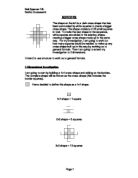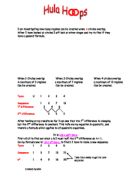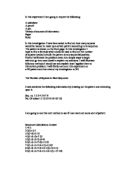Borders - a 2 Dimensional Investigation.
BORDERS The shape on the left is a dark cross shape that has been surrounded by white squares to create a bigger cross shape. The shape consists of 25 small squares in total. To make the next shape in the sequence, white squares are added to the existing shape, creating a bigger cross shape made up in the same way. For my investigation, I am going to work out how many squares would be needed to make up any cross shape built up in this way by working out a general formula. Then I am going to extend my investigation to 3 dimensions. I intend to use structure to work out a general formula. 2 Dimensional Investigation I am going to start by building a 1x1 cross-shape and adding on the borders. The complete shape will be known as the cross-shape (this includes the border squares). I have decided to define this shape as a 1x1 shape. x1 shape = 1 square 2x2 shape = 5 squares 3x3 shape = 13 squares 4x4 shape = 25 squares 5x5 shape = 41 squares 6x6 shape = 61 squares I now have enough data to analyse my results: Number in sequence (n) Total number of squares (tn) 2 5 3 3 4 25 5 41 6 61 To work out which formula to use I will now put my results in a table showing the differences between the numbers: n tn 1st difference 2nd difference 1 4 2 5 4 8 3 13 4 12 4 25 4 16 5 41 4 20 6 61 I can clearly see that the 2nd difference is the
Chessboard coursework
How many squares on a chess board Introduction This is my first piece of mathematics coursework. In this project I will be finding out how many squares on a 8x8 chess board. In this project I will be including labelled drawings, clear enough to allow a non mathematician to follow, clearly written work, initial drawings of each of my steps and a finished formula justified. Finally an extension on my board making it rectangular. Plan * Introduction * Spider diagram * I will be collecting data from different sized grids ranging from 2x2 to 8x8. * Explanation of how to add up the squares on the grid * Further calculations * Create a table of values. * Formula and formula justified * Draw a graph * Extension * Conclusion * Evaluation Tree diagram Explanation of how to add up the squares on the grid . Count how many singular squares there are =16 2. Count how many double squares there are. =9 3. Continue this until you complete the whole shape in this case 4x4. 4. Once you have completed this you should have 208 squares on the 8x8 grid. Further calculations x1=1 2x2=5 3x3=14 4x4=30 5x5=......... x1 1x1=1 =1 2x2 2x2=4 (2-1)x(2-1)=1x1=1 =4+1=5 3x3 3x3=9 (3-1) (3-1)=2x2=4 (2-1) (2-1)=1x1=1 =9+4+1=14 4x4 4x4=16 (4-1)x(4-1)=3x3=9 (3-1)x(3-1)=2x2=4 =16+9+4+1=30 (2-1)x(2-1)=1x1=1 Check 4x4 2 2 2
A Square Investigation
A SQUARE INVESTIGATION Aim: The aim of this investigation is to find any rules, patterns of square numbers. Patterns/ rules will be discussed step by step below. Firstly a square number is a number multiplied by it. The name becomes apparent if one looks at a diagram of a square. e.g. 2^2 = 2*2= 4sq units; we say 4 is the square of 2. Hence a square number gives the area of a square. Method: the first step was to draw the table below. (Explain what each column means, draw a graph). X NUMBER X^2 SQUARE NO. OF TENS DIFFERENCE NO. OF UNITS 0 0 0 0 0 0 2 4 0 0 4 3 9 0 0 9 4 6 6 5 25 2 5 6 36 3 6 7 49 4 9 8 64 6 2 4 9 81 8 2 0 00 0 2 0 1 21 2 2 2 44 4 2 4 3 69 6 3 9 4 96 9 3 6 5 225 22 3 5 6 256 25 3 6 7 289 28 3 9 8 324 32 4 4 9 361 36 4 20 400 40 4 0 21 441 44 4 22 484 48 4 4 23 529 52 4 9 24 576 57 5 6 25 625 62 5 5 26 676 67 5 6 27 729 72 5 9 28 784 78 6 4 29 841 84 6 30 900 90 6 0 31 961 96 6 32 024 02 6 4 33 089 08 6 9 34 156 15 7 6 35 225 22 7 5 36 296 29 7 6 37 369 36 7 9 38 444 44 8 4 39 521 52 8 40 600 60 8 0 41 681 68 8 42 764 76 8 4 43 849 84 8 9 44 936 93 9 6 45 2025 202 9 5 46 2116 211 9 6 47 2209 220 9 9 48 2304 230 0 4 49
I am investigating how many regions can be created when n circles overlap. After I have looked at circles I will look at other shape and try to find if they have a general formula.
I am investigating how many regions can be created when n circles overlap. After I have looked at circles I will look at other shape and try to find if they have a general formula. When 2 Circles overlap When 3 Circles overlap When 4 circles overlap A maximum of 3 regions a maximum of 7 regions a maximum of 13 regions Can be created. Can be created. Can be created. Term U 1 2 3 4 Sequence 1 3 7 13 st difference 2 4 6 2nd difference 2 2 2 After looking at my results so far I can see that the 1st difference is changing but the 2nd difference is constant. This tells me my equation is quadratic, and there's a formula which applies to all quadratic equations. It is: Un = an*+ bn+c First of all to find out what a is I must half the 2nd difference so A = 1, So my formula now is: Un = n*+bn+c, to find b I have to make a new sequence. Term 1 2 3 4 5 Sequence 1 3 7 13 21 n* 1 4 9 16 25 New 0 -1 -2 -3 -4 Sequence st difference -1 -1 -1 -1 -1 And B Is the difference of the new sequence so b= -1 our formula now is Un = n*- n + c Now I have to find c we will have to put the formula into action: If n = 1 U1 = 1* - 1 + c and because u = 1 c must be +1 so the formula must be Un = n* - n + 1 My predicted formulae is n = n* - n + 1 This is the formula for the maximum number of regions Here is a table of results to show if
In this course work I have been asked to find out how many squares will be needed to make up a certain pattern according to its sequence.
INTRODUCTION In this course work I have been asked to find out how many squares will be needed to make up a certain pattern according to its sequence. I hope to find a formula that could be used to find the number of squares needed to build the next pattern at any of the sequences. I will carry out this experiment on a 2d pattern and then try doing it on 3d pattern. st sequence black square 0 white square 2nd sequence 1 black square 4 white squares 3rd sequence 5 black squares 8 white squares 4th sequence 3 black squares 2 white squares 5th sequence 25 black squares 16 white squares 6th sequence 41 black squares 7th sequence 20 white squares 61 black squares 24 white squares 8th sequence 85 black squares 28 white squares 9th sequence 113 black squares 32 white squares In these drawings I have noticed that if we look at the symmetrical sides of the pattern and then add up the number of squares we can get a square number. From it. No of sequence Black squares White squares Total 1st difference 2nd difference 1 1 0 1 4 4 2 1 4 5 8 4 3 5 8 13 12 4 4 13 12 25 16 4 5 25 16 41 20 4 6 41 20 61 24 4 7 61 24 85 28 4 8 85 28 113 32 4 9 113 32 14 5 36 4 10 145 36 181 40 4 11 181 40 221 44 4 12 221 44 265 4 Table showing my results. I have achieved these results in the
2D & 3D Sequences.
2D & 3D Sequences Plan of Investigation In this experiment I am going to require the following: A calculator A pencil A pen Variety of sources of information Paper Ruler In this investigation I have been asked to find out how many squares would be needed to make up a certain pattern according to its sequence. The pattern is shown on the front page. In this investigation I hope to find a formula which could be used to find out the number of squares needed to build the pattern at any sequencial position. Firstly I will break the problem down into simple steps to begin with and go into more detail to explain my solutions. I will illustrate fully any methods I should use and explain how I applied them to this certain problem. I will firstly carry out this experiment on a 2D pattern and then extend my investigation to 3D. The Number of Squares in Each Sequence I have achieved the following information by drawing out the pattern and extending upon it. Seq. no. 1 2 3 4 5 6 7 8 No. Of cubes 1 5 13 25 41 61 85 113 I am going to use this next method to see if I can work out some sort of pattern: Sequence Calculations Answer =1 1 2 2(1)+3 5 3 2(1+3)+5 13 4 2(1+3+5)+7 25 5 2(1+3+5+7)+9 41 6 2(1+3+5+7+9)+11 61 7 2(1+3+5+7+9+11)+13 85 8 2(1+3+5+7+9+11+13)+15 113 9 2(1+3+5+7+9+11+13+15) +17 145 What I am doing above is shown with the aid of a
Find out how many squares would be needed to make up a certain pattern according to its sequence.
In this experiment I am going to require the following: A calculator A pencil A pen Variety of sources of information Paper Ruler In this investigation I have been asked to find out how many squares would be needed to make up a certain pattern according to its sequence. The pattern is shown on the front page. In this investigation I hope to find a formula which could be used to find out the number of squares needed to build the pattern at any sequential position. Firstly I will break the problem down into simple steps to begin with and go into more detail to explain my solutions. I will illustrate fully any methods I should use and explain how I applied them to this certain problem. I will firstly carry out this experiment on a 2D pattern and then extend my investigation to 3D. The Number of Squares in Each Sequence I have achieved the following information by drawing out the pattern and extending upon it. Seq. no. 1 2 3 4 5 6 7 8 No. Of cubes 1 5 13 25 41 61 85 113 I am going to use this next method to see if I can work out some sort of pattern: Sequence Calculations Answer =1 1 2 2(1)+3 5 3 2(1+3)+5 13 4 2(1+3+5)+7 25 5 2(1+3+5+7)+9 41 6 2(1+3+5+7+9)+11 61 7 2(1+3+5+7+9+11)+13 85 8 2(1+3+5+7+9+11+13)+15 113 9 2(1+3+5+7+9+11+13+15) +17 145 What I am doing above is shown with the aid of a diagram below; If we take sequence 3: 2(1+3)+5=13 2(1
Number Grid Investigation.
Number Grid Investigation I was first given A 10x10 grid, counting from 1-100. Inside the grid was A 2x2 box surrounding the numbers, 12, 13, 22 and 23; 2 3 4 5 6 7 8 9 0 1 2 3 4 5 6 7 8 9 20 21 22 23 24 25 26 27 28 29 30 31 32 33 34 35 36 37 38 39 40 41 42 43 44 45 46 47 48 49 50 51 52 53 54 55 56 57 58 59 60 61 62 63 64 65 66 67 68 69 70 71 72 73 74 75 76 77 78 79 80 81 82 83 84 85 86 87 88 89 90 91 92 93 94 95 96 97 98 99 00 I was asked to; * Find the product of the top left number and bottom right number in the box. * Do the same with the top right and bottom left numbers n the box. * Calculate the difference between these numbers. I did this, 2 x 23 = 276 3 x 22 = 286 286 - 276 = 10 The difference between them was 10 I decided to try it with A 3x3 box surrounding the numbers; 2 3 4 22 23 24 2 x 34 = 408 4 x 32 = 448 448 - 408 = 40 The difference between them was 40 I also tried this with A 4x4 box, and A 5x5 box: (4x4) 12 x 45 = 540 15 x 42 = 630 630 - 540 = 90 (5x5) 12 x 56 = 672 16 x 52 = 832 832 - 672 = 160 I decided to try and find A pattern between these numbers, I thought that since the boxes grows in an even number, so should the totals. Put into order they looked like this: Side of box length 2 3 4 5 Difference in
This coursework will be to investigate to see how many squares would be needed to make any cross-shape build up in this way.
Introduction The figure below shows a dark cross-shape that has been surrounded by white squares to create a bigger cross- shape: The bigger cross- shape consists of 25 small squares in total. The next cross- shape is always made by surrounding the previous cross-shape with small squares. This coursework will be to investigate to see how many squares would be needed to make any cross-shape build up in this way. Method First of all I'm going to work out a sequence which consists of a formula. Then I will draw a maximum of six cross-shapes adding on to each sequence, at the end I will produce one extra to testify the formula. After creating two tables to work out the first and second differences between the number of squares, I'll use those to find the values of a , b and c. Table 1 Shape Number 2 3 4 5 6 Number of Squares 5 3 25 41 61 st Difference 4 8 2 6 20 24 2nd Difference 4 4 4 4 4 4 No of squares: 1 5 13 25 41 61 st Diff: 4 8 12 16 20 2nd Diff: 4 4 4 4 To find the 1st and 2nd difference, I used a table and then the diagram above to check if I was right about my suggested answers. First of all, for the 1st
Portfolio: Continued Fractions
Continued fractions A continued fraction is a fraction whose numerator is an integer and whose denominator is an integer added to a fraction whose numerator is an integer and whose denominator is an integer added to a fraction, and so on. The continued fraction above is the first continued fraction to consider. But how do the ten first terms look like, and how does the relationship between them look like? Table 1. The ten first terms of the continued fraction above. n 2 3 4 5 6 7 8 9 0 tn tn 2.00 .50 .67 .60 .63 .62 .62 .62 .62 .62 The ten first terms of the sequence, which can be seen in Table 1, led me to the generalized formula for the sequence. However this sequence is not just a regular sequence, it is the Fibonacci sequence. And the Fibonacci sequence is a recursive sequence, which is a sequence in which a general term is defined as a fraction of one or more of the previous term. Graph 1. The value of the terms versus the term numbers. As n increases does the difference between the value of a term and the value of the term before decrease. This towards a specific value, and since we know that the sequence is the Fibonacci sequence we also know that the specific value the terms is moving towards is the golden ratio. When looking for the exact value of, for example, the 200th term problems arise. Mostly because of the fact that it is hard











